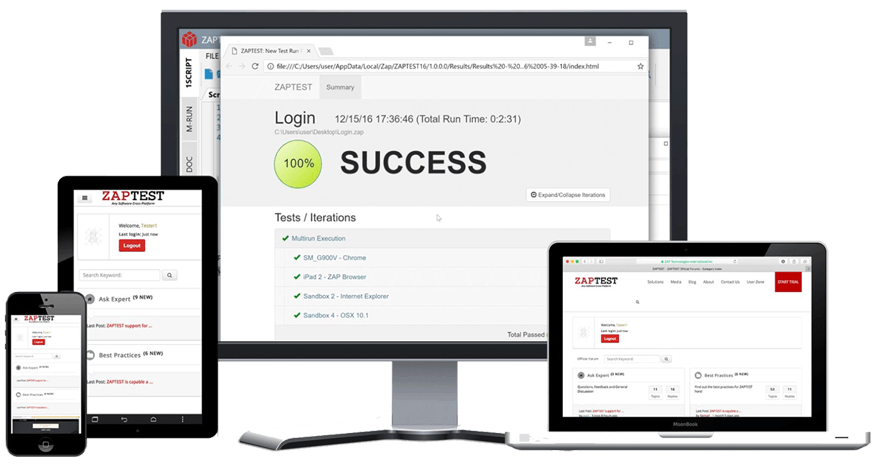You may have heard project managers, quality assurance, and developers arguing over the merits of unit testing and whether your team needs it. If that decision is yours to make, it helps to have the facts so that you can make the best decision for our project.
Like most things in the software industry, there are benefits and drawbacks to unit testing. Understanding the process, applications, benefits, and challenges can help you decide if unit testing is necessary for your team.
What Is Unit Testing?
Unit testing is a method for isolating and testing specific units of code to determine each component’s efficacy. Instead of testing the software, this method breaks it down into smaller sections to ensure the correctness of individual components.
Why Do We Need Unit Tests?
Since unit tests typically occur during the development phase, they allow teams to identify and correct issues before releasing the software. Unit tests alert developers to potential errors or gaps that could trigger problems in the future and improve the overall quality and performance.
Unit testing remains a somewhat controversial topic in the industry. Quality assurance teams champion software testing while coders caution against overuse, and few teams arrive at a consensus. Understanding the bigger picture can help you wade through the arguments and arrive at the best decision for your business.
What Should You Test In Unit Testing (And What You Shouldn’t)?
Unit testing is a tool that has a time and place like any other tool in your arsenal to improve software efficiency and cost-effectiveness. It can accomplish a lot but may not be your best option in every situation.
There are distinct advantages to using unit testing in the following scenarios:
- Take a test drive to make sure the code works before deploying it.
- Check the work to validate the code’s function and identify potential defects.
- Document the process to support best practices and track progress.
It might be tempting to expand the use of unit testing, but its limitations could create challenges too if you use it in particular situations. For example, performing a unit test on components that work with third-party systems might not yield consistent or reliable results. The task is too complex to break down into smaller components without losing something.
Unit testing also creates an issue with complex systems, like AI and Robotic Process Automation (RPA). While you can perform unit tests in these scenarios, it is a massive undertaking, and better tools are available.
Benefits of Unit Testing
It is important to note that unit testing typically occurs early in the development process as a proactive measure or before introducing new code to an existing system. Including software unit testing in your existing testing plan can benefit your project in expected and unexpected ways.
1. Saves Time and Money
Perhaps the most valuable reason to incorporate unit testing is the impact on your release timeline and bottom line. While it adds extra steps to the development process, unit testing isn’t as time-consuming or costly as searching for a minor defect in your finished product months after delivery.
Since unit testing searches for defects and potential issues by testing the code against various conditions, it allows for faster, easier corrections. Tweaking the code as the project develops is an efficient and more effective use of human and financial resources.
Finding and identifying potential defects through unit testing early in the process is one of the most practical steps you can take. It is cheaper and easier to address existing and potential issues before delivering the product to your client.
2. Improves Quality
Unit testing also improves the product’s quality by addressing issues before they create problems. You can deliver a higher-quality product knowing that it passed a battery of tests down to the smallest level.
It also allows teams to examine performance by stressing the software throughout the development process to ensure its readiness. Your team can experiment with various scenarios, including extreme conditions, to determine how the software would respond.
Successful testing allows teams to address any shortcomings and deliver a more robust, more complex product.
3. Provides Documentation
Unit testing involves a record that documents the entire process, from the test data process management to each component’s functions. It provides an outline and overview of the whole system and showcases the software’s capabilities and ideal uses while offering insight into inappropriate uses.
4. Increases Overall Efficiency
By isolating different parts of the software, unit testing can test the efficacy of individual components. If the smaller components work well on their own, it makes the entire system more reliable.
Further, testing isolated components allows developers to catch and correct issues before they can impact other components.
Challenges & Limitations of Unit Testing
No system is perfect, and unit testing methods are no exception. Industry professionals disagree on the importance of unit testing because some notable limitations are associated with the process of unit testing.
1. Requires More Code
While unit testing can save you in the long run, it does require extensive coding to test the components. Therefore, one unit testing best practice is to have at least three unit tests to ensure you always have a tiebreaker.
2. Does Not Address Every Situation
Unit testing isn’t ideal for every possibility, especially testing a UI interface. It also cannot possibly catch every error because it is impossible to predict every potential situation.
3. Makes Change Difficult
Shoring up individual components creates a stronger program. What happens when you need to change or update that program? It is more challenging to alter a system that is so insulated against errors without disrupting the overall function.
Types of Unit Testing
Unit testing is usually performed by an automated unit testing tool, but it is also possible to take a manual approach. Both methods have benefits and drawbacks to consider, though automated unit testing is the most popular and essential step for companies embracing hyperautomation, codeless technologies & scalability, agility, and and strong TCoEs culture.
1. Manual Unit Testing
Manual unit testing relies on testers who can understand complex functions and features. Since humans can think outside the box, they can identify issues beyond the code and simulate the user experience.
On the downside, manual unit testing is expensive because you have to pay skilled coders. It’s time-consuming and complicated because teams must isolate individual components and run multiple tests on each one.
2. Automated Unit Testing
Automated unit testing uses programs and code to carry out the tests. Like other software testing automation, software unit testing works faster and limits the impact on other components. Additionally, you can write the test once and reuse it multiple times.
Unfortunately, it takes time to create the necessary code and maintain it. Automated unit testing still has some limitations because it can’t catch every error.
Characteristics of a Good Unit Test
Unit testing requires a delicate balance to increase the benefits and tackle the limitations. The best unit testing features four characteristics that create this balance.
1. Isolated
Every unit test should be able to stand alone, meaning they can exist independently of other factors. If the test relies on other programs or systems to operate, then it can alter the results.
2. Fast
Consider the volume of code to be tested and how long it would take to perform enough tests to produce satisfactory results. A good unit test should take mere milliseconds to complete testing. Further, the unit test should not take long to create than the components you intend to test.
3. Consistent
Unit tests should return identical results every time. If you cannot repeat the test multiple times and achieve the same results, it is not reliable.
4. Self-Checking
Manual and automated unit tests should be able to reveal the results automatically without human intervention. Your team should not have to sift through the results to determine if it’s a yes or no.
Cutting Through the Jargon: Unit Tests vs. Integration Tests
Software testing is as complex as the programs it tests, which means various terms and types accomplish different things. Understanding the difference between unit tests and integration tests is necessary to determine the best way to implement each.
1. What are Integration Tests?
Integration testing addresses how various components work together within the program. It identifies any issues between components as they come together to perform tasks. Some issues might support the software, but this testing seeks out those that detract from the overall performance.
2. Unit Tests vs. Integration Tests
Unit testing and integration testing are similar concepts that address different elements. Instead of looking at the individual function of the smallest unit, integration testing looks at how the components work together.
Integration testing also looks for defects and side effects early in the process and finds issues that aren’t obvious at first glance. However, integration testing is concerned with multiple components as they interact with each other instead of individual functionality.
Unit Testing Techniques
Three unit testing techniques address different layers within the system. Both manual and automated testing can cover these types.
1. Functional Unit Testing Techniques
Functional unit testing methods, known as black-box testing, address each component’s functionality. It evaluates the validity of the user interface, input, and output while establishing boundaries and equivalencies.
2. Structural Unit Testing Techniques
Structural techniques or white-box testing validate components that meet established functional requirements and map their paths. For example, it might involve setting a series of conditions to see which path the code follows through the program based on the input.
3. Error-Based Unit Testing Techniques
Error-based techniques work best if the original programmer handles the testing because they are familiar with their work. Also known as gray-box testing, this uses test cases and performs risk assessments to identify defects.
Applications of Unit Testing
As noted, the unit testing applications are nearly endless, but it serves some purposes better than others.
1. Extreme Programming
Extreme programming is one software development ideology that strives to create the highest quality software. This methodology relies heavily on software unit testing frameworks to carry out comprehensive testing. Extreme programmers frequently use automated testing tools to improve overall quality and responsiveness while adapting to evolving customer needs.
One of the guiding principles is to test everything that can potentially fail, including the smallest components. Consequently, unit testing is a powerful tool for extreme programmers.
2. Language-Level Unit Testing
Certain languages are innately compatible with unit testing. For example, languages like Python and Apex directly support unit testing because of the code’s structure, meaning it takes limited adjustments to incorporate unit tests. Other languages require minor modifications and special frameworks, like PHP unit testing.
3. Unit Testing Frameworks
Unit testing opens a door for third-party products that you can install to run the tests on your existing system. Many automated unit testing tools are compatible with multiple languages to simplify the testing process and allow users to check their previously developed software.
How To Write a Test Case for Unit Testing
Writing unit testing test cases can become complicated depending on the component you test; writing the unit test should center on the same three points. Note that there might be slight differences between manual and automated testing, but the process is essentially the same.
1. Test to Check a Valid Response
Start with a test that checks the optimal response to ensure it recognizes what should occur. This step also establishes the baseline.
2. Test Response to Invalid Input
Establish a test to check the response to invalid input. Create a baseline for the component’s response to invalid data.
3. Perform Multiple Actions
Test the component repeatedly using valid and invalid responses to determine how the component reacts. Then, track the responses to seek out any defects.
How Do We Do Unit Testing?
Unit testing involves writing code to test a specific component within the software. Manual testing typically takes more steps and isn’t particularly common, so let’s look at the process using unit testing automation tools.
One of the most popular tools on the market is ZAPTEST API Studio. With ZAPTEST users can automate testing of REST; SOAP; and openAPI using full parameterization, and easy-to-use correlation and data management utilities.
ZAPTEST also provides the ability to merge API and UI testing in a seamless process.
1. Identify the Section of Code to Test and Determine the Method
Developers can write and attach code to the application to test a component’s function and remove the test code later. Conversely, it’s possible to isolate the component and copy it into a test system. The latter allows users to identify any unnecessary links to other components during the test.
2. Initiate Test Cases
The developer uses test cases devised by the coder to validate the component’s functionality. This process typically occurs in an automated test framework that flags any defects during the test and can alert the team to a failure.
3. Review and Rework
Once the test case is complete, the team can review the data to determine any defects or errors. Then, the team makes corrections and updates the component before testing it again.
Teams can revisit the test cases as often as needed to achieve the desired results. It is possible to stop a unit test, meaning the component or the test case failed so severely that it isn’t worth continuing.
Examples of Unit Tests
There are hundreds of unit testing examples that address various components and issues. Here are a few basic unit test examples that demonstrate real-world applications.
1. API Unit Testing
Modern systems rely on different programs communicating with each other, often relying on interfaces known as APIs. For example, developers can increase efficiency by testing the endpoints through unit testing of a REST API.
2. Automotive Industry
The automotive industry offers a vast opportunity for unit testing examples so consider the broad implications. Our vehicles rely more on code than ever and can create dangerous situations if there is even a slight defect. Unit testing tools can isolate code before the car even leaves the factory to determine if it’s clear and reduce the chances of faults on the road.
Best Practices for Unit Testing
Whether you want to do unit testing on a REST API or determine how a banking application responds to different inputs on the same account, these best practices can keep your unit testing on track.
1. Write and Follow a Unit Testing Plan
One of the most important elements of unit testing is adhering to a plan that details the size, scope, and objectives. Define the scope of your unit test and what you need to test, determine the test cases, and select the proper unit testing tools or software.
Simply creating a unit testing plan isn’t sufficient; your team needs to follow the plan from beginning to end. Skipping steps or deviating from the plan can lead to confusion and create unnecessary work.
2. Consider the Language
Make sure your code speaks the same language as the program or application you are testing. PHP unit testing differs from C# unit testing even though the general framework looks similar.
3. Reintegration and Regression Testing
If you copied the code and tested it in a testing framework instead of within the application, regression testing is critical. Reworking any code can alter an application’s functionality, so reintegrate the unit and then do regression testing to ensure it works properly.
Who Should Be Involved in Unit Tests?
Though many people contribute to software development and applications, not everyone has the time, skill, or knowledge to participate in unit testing. Therefore, restrict the team to a few qualified individuals or teams.
1. Software Developers Perform Unit Testing
The developers bear the brunt of the responsibility with unit testing because they know their code and how it should function. Developers write the test cases, implement the test, and typically have the best idea of what unit testing software to employ.
2. Quality Assurance Team
The QA testing team knows how the software should work and how to identify defects. They view the software from a different perspective and ensure it functions properly within the larger system.
Unit Testing Checklist
This unit testing checklist is a guideline to help your team stay on track to meet the objectives.
1. Choose the Right Unit Testing Tools
Choosing the right unit testing automation tools is essential. Make sure the unit testing software is compatible with your application’s language and can achieve your team’s goals.
2. Set Up for Success
Create detailed names for the test project so that future teams know what was done and can easily identify the test. Identify the code you intend to test and make certain it’s completely independent.
3. Test Code Individually
Only test one component at a time to remain consistent and expedient, as well as avoid overlap or miscommunication between team members.
4. Reproduce Defects
If you identify a defect, test again to make sure the same action returns the defect again. Correct the defect if it’s reproducible.
Conclusion
Unit testing is a way to improve software and application efficiency by testing the smallest components’ correctness. It represents another opportunity to refine existing software and increase efficiency.
For those interested in software automation and robotic process automation tools, unit testing fills a support role in the journey toward hyperautomation. Because it breaks applications into the smallest components, it can identify formerly unnoticed defects and prevent future issues before they develop into problems and delay production.
Like other automation tools, it is important to use unit testing judiciously and follow the industry’s best practices.
FAQs
Unit testing is a powerful opportunity for businesses to improve software and applications.
What is unit testing in C#?
Unit testing in C# involves isolating segments of code that represent the smallest components and testing their correctness with unit testing automation tools.
What is unit testing in Java?
Unit testing in Java requires a framework to test the behaviors of bits of code before using it in production.
What is unit testing in software engineering?
Unit testing in software engineering isolates the smallest, testable component in an application and tests its validity and performance.





